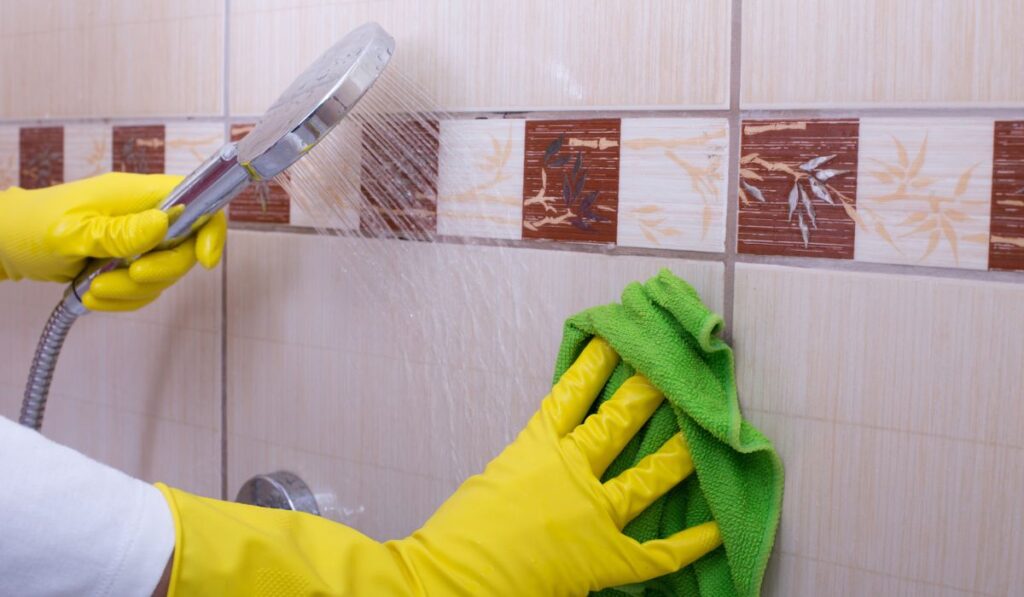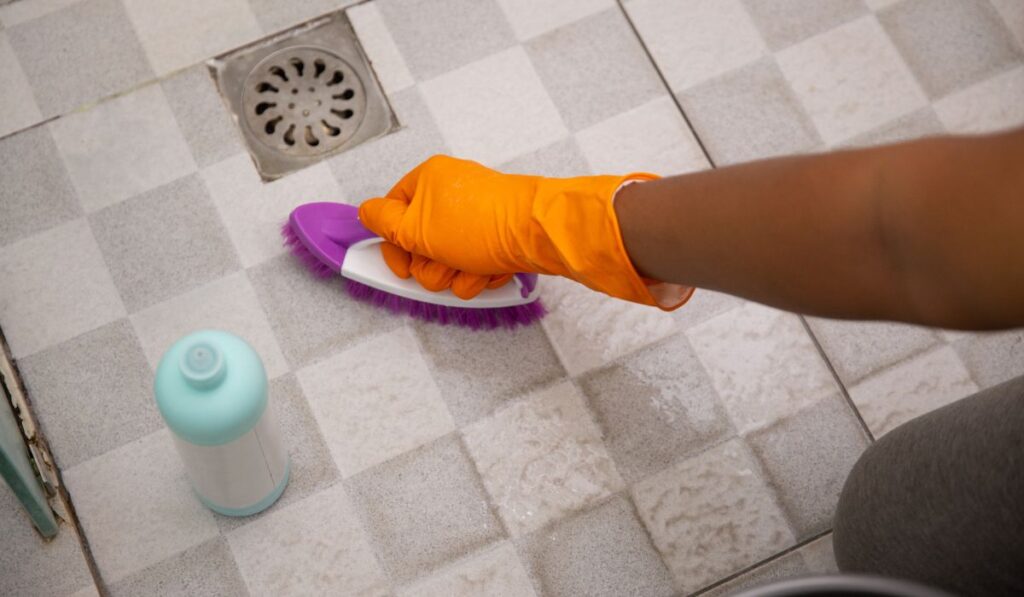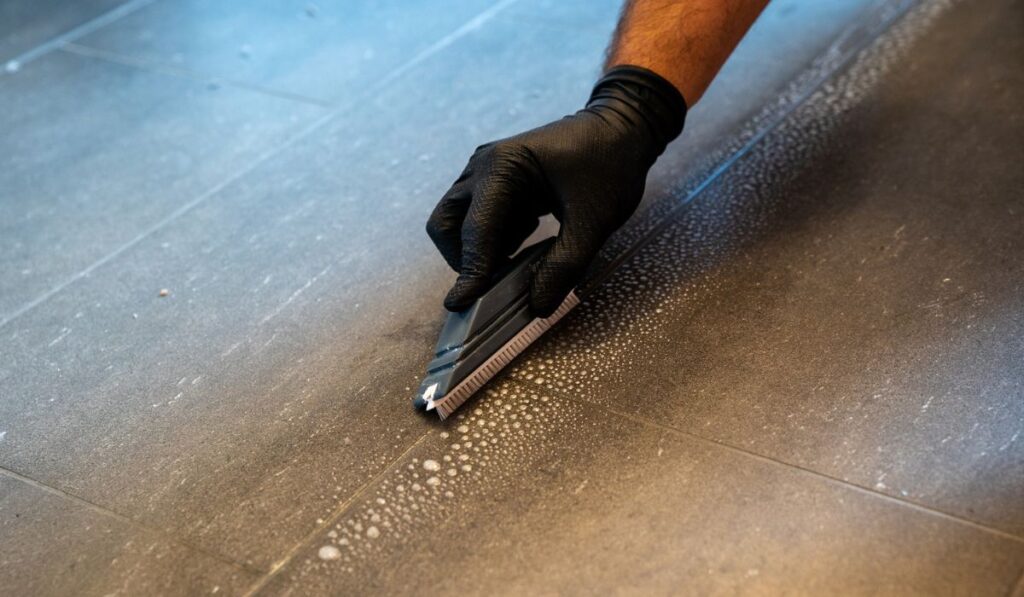Flooring plays a vital role in your home’s aesthetics. However, if your bathroom floor tiles are worn out, hiding them under a rug won’t cut it, and remodeling may be a costly project. Luckily, you can spruce up your bathroom flooring by covering them with some attractive options.
If you want to cover your bathroom floor without removing the tiles, consider painting the floor with stencils that match your unique personality. You can also lay peel-and-stick vinyl over your bathroom tiles. To achieve a rustic look, lay floating laminate flooring with a wood finish.
When choosing a cover for your tiled floor, consider factors such as bathroom ventilation, size, and budget. Options such as laminate flooring are vulnerable to moisture damage, while water-resistant stickers are budget-friendly. Read on for more tips about covering your bathroom floor tiles.
What are Possible Solutions for Covering Tile Floors?
Covering old tiles can be a convenient way to revamp your bathroom’s look without remodeling. There are various solutions to coating worn-out bathroom tiles. They include:
Paint the Tiles
Before painting your tiles, be sure to clean them and use water-resistant paint. Use oxygen bleach to clean the tiles and grout lines, then prime the floor using a high-adhesive oil-based primer.
Once the primer dries, you can apply oil-based or latex paint with a resin base. Finally, coat the paint with three coats of clear finish for added protection.
Add a flair to your bathroom flooring by painting the tiles with stencils. Order a tile stencil (on Amazon) that matches your tile size, and apply the stencil with paint with each tile. Stencil painting allows you to create beautiful mosaic designs.
Use Peel and Stick Vinyl Flooring
Vinyl peel-and-stick flooring (on Amazon) is affordable and readily available. Their unique construction allows you to lay them over tile flooring. Then, choose groutable vinyl flooring to achieve a finished look.
Most brands offer vinyl wood that resembles natural wood flooring. These floor panels adhere to the tiles well after a bit of preparation, and installing them is fast. In addition, they are easy to trim at only millimeters thick.
Vinyl flooring is durable and can withstand heavy impact. In addition, it has few joints over the grout, limiting the water seepage.
Install Laminate Flooring
Although it may be a bit more costly than other options, laminate flooring (on Amazon) can transform your home’s interior. Choose laminate flooring with moisture-lock barriers to prevent water from seeping beneath the boards.
Most designs have pre-installed vapor barriers to protect your flooring and save installation time, and they are easy to install and remove for added convenience. Choose from a wide range of colors to match your bathroom decor.
With a natural wood grain appearance, these panels add a touch of elegance to your interior.
Use Epoxy Coating
Since epoxy resin coating (on Amazon) is heat and moisture-resistant, it supports use indoors and outdoors. 3D epoxy flooring is a recent breakthrough that produces specialized three-dimensional flooring effects and optical illusions. Now you can create realistic representations of fish, plants, corals, and other designs using epoxy.
Consider Cleaning Your Tiles

Cleaning is an efficient and cost-friendly option for dealing with your bathroom’s tile floor. It brightens the tiles and refreshes their appearance. However, your tile may be unsightly because you’ve never been able to adequately clean the blackened and moldy grout.
Oxygen bleach (on Amazon) soaks into dirty grout and loosens grime and mold, allowing you to scrape them away. Dissolve oxygenated bleach in water, then apply the solution to your tiles, allowing it to soak for 30 minutes before scrubbing with a scrub brush.
Rinse the tiles with clean water and wipe them clean using a towel.
How to Achieve a Hardwood Floor Look Using Laminate
You can’t install a natural hardwood floor over tile, but you can use a floating laminate floor that resembles. Made by fusing many layers of synthetic materials and a laminate finish on top, laminated wooden flooring looks like natural wood.
This flooring is lightweight, easy to maintain, comes in multiple colors, and is an excellent method to add warmth to your home’s interiors. However, one disadvantage of installing laminated wooden flooring is that it disintegrates when exposed to excess moisture.
Although you should thoroughly clean tiles before overlaying them, a laminate floor does not need special cleaning. You only need to install a foam underlayment to cushion the floor and block dampness.
Considerations Before Covering Your Bathroom Tiles
Cleaning the tiles is your best option before replacing or covering existing tiles. If your bathroom has inadequate ventilation and you frequently notice water droplets accumulating on the walls and floor, cover them with vinyl flooring.
Paint may not withstand prolonged exposure to wetness, even if you cover it with numerous coats of floor finish. Similar to other types of flooring, laminate is susceptible to moisture; the boards can discolor, curl, and, in severe cases, delaminate.
Consider an exhaust system in your renovation plans if your bathroom has excessive moisture because it will likely cause harm to your lighting and plumbing.
Cleaning Bathroom Tiles

It’s crucial to properly clean bathroom tiles to maintain good hygiene and prevent damage or wear over time.
Depending on the type of tile you have, there are several cleaners for bathroom tiles. First, choose the correct cleaner for the job because ceramic and porcelain tiles have different cleaning requirements than natural stone ones.
Choosing a tile cleaner (on Amazon) also depends on how environmentally conscious you are. Some people prefer using natural ingredients exclusively, while others can opt for professional-grade cleaning agents.
Consider using a PH-neutral cleaner, orange oil, and white vinegar solution to ensure effective deep cleaning.
Best Cleaning Practices
Avoid harsh chemicals on bathroom floor tiles, and consider using cleaners with natural ingredients. To clean the tile surface, use a PH-neutral cleaner and a non-abrasive cloth.
Natural cleaning agents are best for your tile because they aren’t as harsh as chemicals or solvents. For example, vinegar works well for cleaning bathroom tiles. Dilute equal amounts of white vinegar and water in a spray bottle before spraying directly onto the surface.
This solution can eliminate scum from other bathroom surfaces like wall tiles and glass. Ensure to buff the surfaces dry to avoid unsightly streaks.
Tiles with a glossy glaze need cleaning and dusting each month. First, clean them with a non-abrasive cleaner and a microfiber cloth, then buff the tiles with a fresh, dry cloth for a streak-free finish. Make sure to polish the glass mosaics in your bathroom dry as well to prevent unattractive wet spots.
Try using a fresh, wet toothbrush to remove dirt and limescale from tiny crevices in textured tiles. Baking soda paste is a beautiful cleaning solution for textured bathroom tiles. Combine three cups of baking soda with a cup of warm water and use the mixture to scrub tiles.
You can also use this baking soda paste to clean grout lines.
How to Clean the Grout

Grout keeps the tiles together, but its porous nature makes it vulnerable to stains and water damage. Fresh grout has a lovely appearance but can develop stains, mildew, and even crack if it is not cleaned and maintained correctly.
If you want to clean your tiles and stop them before staining and damage, you must follow a regular wiping and spraying regimen after a bath. Although it could seem tedious, it will save you costs and work in the long run.
Buy a quality squeegee and run it over the tiles after each bath or shower to eliminate any extra water. Then, use a gentle, everyday shower cleaner to lightly mist your tiles and glass. Get an eco-friendly cleaner or formulate your own by combining water with vinegar solution at a 4:1 ratio.
Test different cleaners and see which one works best for you.
Deep Cleaning
You will need to give your bathroom a deep clean at least once or twice a week, even if your daily routine will keep your floor. This is because, despite regular cleaning efforts, body oils and soap scum will still adhere to the surfaces.
Use a mixture of water and baking soda to clean your grout thoroughly. A grout brush or an old toothbrush can help you work the mixture into the grout before rinsing it with clean water. Use hydrogen peroxide instead of water if your grout appears slightly more discolored than usual.
Ensure to thoroughly rinse the bathroom if you use vinegar as your everyday shower cleaner before applying hydrogen peroxide to the grout.
Because of carelessness or lack of attention, grout gets so dirty and ruined that baking soda paste or your regular shower cleaner isn’t cutting it anymore. In this situation, consider using bleach to remove the stains.
Using a bleach pen is the best approach to concentrate the strength of bleach where you need it most. However, while a bleach pen minimizes potential contact with your tile and is perfect for smaller surfaces and light grout work, you can’t use it to clean all the grout lines.
Use it for added strength in areas where weekly or biweekly cleanings are insufficient.
